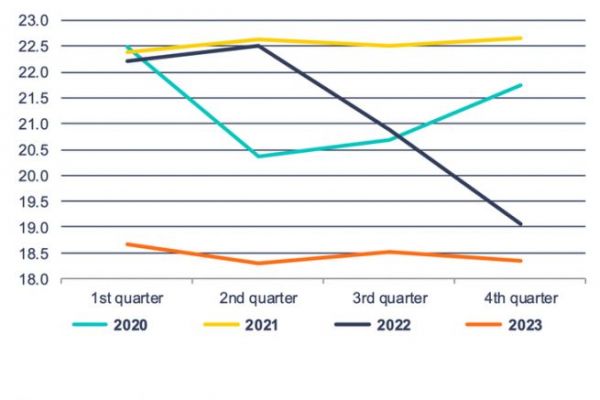For the second year running paper and board production in Europe is set to decline by ‚euros 12.8% over 2023 . According to the latest report from the Confederation of European Paper Industries (Cepi), published on February 14, this decline in European Cepi* member countries can be explained by the unfavorable macro-economic environment, destocking in the supply chain and the impact of persistently high energy costs.
Cepi notes that after a year of exorbitant energy prices in 2022, the drop in production in 2023 will be even more pronounced than during the Covid-19 crisis (-4.7% in 2020).
Decline in global paper and board production
Total production for the year came to 74.3 million tonnes, with all paper and board ranges down.
A drop in production was also observed in most regions of the world, but to a lesser extent. Canada, Japan, the United States and South Korea recorded production declines of between 2.0% and 9.8% .
The use of paper for recycling by companies in the geographical area covered by Cepi members has fallen by 6.9% compared with 2022, as raw material production has itself decreased. This decrease is also explained by the fact that some graphic paper mills using paper for recycling have closed.
Paper and cardboard demand down 15.3
The economic environment, with high inflation and interest rates, and sluggish private consumption, has had a major impact on demand.
Based on figures available for the first nine months of last year, paper and cardboard consumption fell by 15.3%. It should be noted that this fall would have been less marked if the use of inventories had been taken into account.
As in 2022, bathroom and household paper (handkerchiefs, toilet paper) was the segment that suffered the least down only 3.7%.
Demand for graphic paper which includes printing and writing paper, down 27.5% due to falling demand in the printing and publishing industries.
According to Cepi, this sharp drop can only be partly explained by the widespread use of digital content, since destocking effects could account for up to half of this fall . And within this category, the book sub-segment remained resilient.
In the packaging paper and board sector, traditionally a growth driver, demand continued its downward trend, with consumption down 12.2%.
Graphic paper production hit hard by downturn
The reduction in production (‚euros 12.8%) concerns all paper and board segments.
Visit packaging production fell by 9.1% compared with 2022.
In retail, ‚euro boxboard, mainly used for transport packaging, and ‚euro corrugated board boxes, fell by 4.7%.
Production of cartons mainly used for retail packaging fell by 17.3%.
Production of packaging lines used to make paper bags fell by 15.9%.
Visit overall production of graphic ranges fell by 24.6% newsprint fell by 19.9%, and printing and writing papers by 25.4%, due to production line shutdowns and conversions.
Visit production of printing and writing paper (used for magazines and catalogs, direct mail, directories, etc.) declined differently according to category .
Production of coated mechanical paper fell by 24.4% and of uncoated mechanical paper by 23.4%.
Uncoated woodfree paper ‚euros office paper ‚euros fell by 23.9%, while coated woodfree grades were the hardest hit, down 31.2%.
Overall, production of coated and uncoated graphic papers fell by 27.9% and 23.7% respectively. Production of wood-free graphics was down by 26.4%, while production of mechanical graphic papers fell by 23.9%.
Total pulp production down, market pulp production up
Visit pulp production (integrated + merchant) was down 6.2% compared with the previous year, with total production of around 33.5 million tonnes.
Visit market pulp production was up 4.8% in 2023, driven by dynamic exports to China.
Groundwood pulp production decreased by 12.2%, while chemical pulp production fell by 4.5% compared with 2022. Chemical pulp accounts for 79% of total pulp production.
Packaging, the largest share of paper and board production
For the year 2023, the share of packaging is estimated at 62.3% (versus 60.1% in 2022) of total paper and board production. Graphic ranges account for 22.6% (vs. 25.9% in 2022), with newsprint accounting for 3.7%, uncoated paper for 11.6% and coated paper for 7.3%.
Production of all other ‚euro paper and board grades mainly intended for industrial and special ‚euro uses accounted for 4.8% of total paper and board production, down 12.2%.
Production by sanitary and household paper manufacturers accounted for 10.3% of total paper and board production, down by around 4.4% on 2022.
Europe's trade balance remains positive
Against a global backdrop of weak demand, imports and exports fell by the same amount. Although down 16.4%, the European trade balance for the pulp and paper sector remains largely positive, as it is one of the EU's leading manufacturing sectors by this measure.
Jori Ringman, Cepi General Manager, states: "Of all the macro-economic problems born of the crises of recent years, improving the basic operating and investment conditions for the EU's manufacturing sector, while still a daunting challenge, could still be one of the easiest goals for EU policymakers to achieve."
* Cepi member countries: Austria, Belgium, Czech Republic, Finland, France, Germany, Greece, Hungary, Italy, Netherlands, Norway, Poland, Portugal, Romania, Slovakia, Slovenia, Spain, Sweden and United Kingdom.








